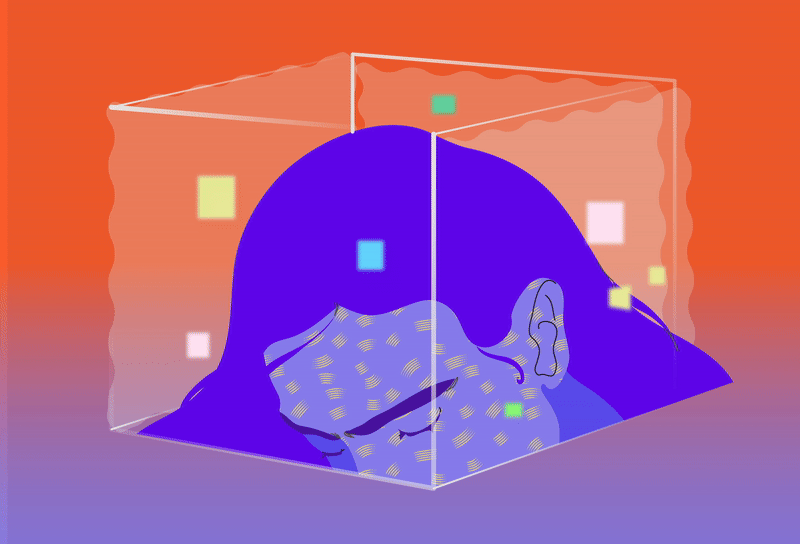Can We Ever “Escape” Our Perception Box?

In What We See When We Read, the novelist and designer Peter Mendelsund reveals a remarkable fact about his own mind. When reading a novel he places all of its actions, scenes, and characters superimposed, like a darkroom’s double exposure, onto his childhood hometown of Cambridge, Massachusetts. Vronsky and Anna have all their affairs in the halls of his local public school. Moby Dick is harpooned in his neighbor’s backyard pool.

The same process happens also, Mendelsund writes, with non-fictions. When he once read historical details about the bombings of Stalingrad, the action took place and the buildings were razed in an alternate, Stalingrad-y version of Manhattan inside his mind.
Mendelsund sums it up beautifully: “We colonize books with our familiars; and we exile, repatriate the characters to lands we are more acquainted with.”
For whatever reason, the influence of Mendelsund’s Perception Box – which was shaped by his genes, experience, and memories – create their own Umwelt, a world experienced only by him, created by his senses. Even the far off, fantastical fictions he reads are forced to fit into only the familiar spaces of memory.
When I read first this account of mind, I was taken aback. That’s not at all how reading happens in my mind.
Sure, I’ve been aware, at times, that in my mind reading fiction or non-fiction can be a perceptually fluid process. Once, while in the process of reading a book at a neuroscience of consciousness conference, I met the book’s author and spoke with him for an hour or so. That night, opening the pages of the same unfinished book, the text was suddenly read aloud in my head in his voice. Which I had just heard, that day, for the first time. (Whose voice was it before? I have no idea. Bizarrely, to me, some people claim to have no voice at all in their head while reading. )
That such a clear change to my inner reading voice can occur within a single day —and that it happens, in fact, without conscious intention—is yet more evidence that the edges of our perceptions, and therefore the contours of our Perception Boxes, are remarkably plastic. They can expand or contract almost immediately with any input. This can be good news or bad news, depending on what that input is. Imagine someone coming up to you as you’re eating your favorite ice cream and saying “that looks like poo.” For some that would ruin the delicious dessert forever.
It’s not only thanks to the world outside of us, but to the world inside us (ie, our Perception Box), that we can never step inside the same river twice.
What is it about Mendelsund’s mind and others like it that offer (force?) this ability or what is it that my mind lacks? Is he less able to visualize unseen, unknown space and therefore more likely to fit all stories to visuals his memory can easily conjure up? Is the cortical circuitry that generates mental images somehow more or less wired to the memory centers of his brain? Is it a kind of stylized trick he has developed in order to remember details better? (The so-called “memory palace” technique, also known as the “method of loci”, aids in memorization and recall in part by using well-known spatial locations in the mind’s eye and memory.)
The exact same novel, if revisited by a future self—wisened, or un-wisened, with age and experience—can cause wholly different perceptions. An old Spanish saying captures this perfectly: “You read Don Quixote three times in your life. The first time it makes you laugh. The second time it makes you think. The third time it makes you cry.”
It’s not only thanks to the world outside of us, but to the world inside us (ie, our Perception Box), that we can never step inside the same river twice.
***
While I was in graduate school, I used to keep a parts list for experimental cocktails I would make. I’d ask of guests only that they give it two ratings each on a scale of 1 to 100: An objective rating and a subjective rating.
Often, I’d then have to explain what I meant by the difference between the two columns. That though they may not like the pine needle-infused, burnt-pear gin martini they might be able to imagine, for some bespoke reason related to their own personal preferences or maybe some childhood, pine nut-adjacent trauma that, on average, others would like it more or less than they did.
I now recognize the question for what it is. Rephrased, I’d say it differently, asking them to rate “From Within Your Perception Box” and “From Outside Your Perception Box”. And yet, without fail, people would proceed to ascribe different ratings for each of the two categories.
I, on the other hand, would proceed to stubbornly write down the exact same number in each column:
Subjective: 85 | Objective: 85
After all, isn’t every rating ultimately, at the end of the day, even those I attribute to others out there in the “objective” world, entirely based on my social world models? And isn’t it therefore always subjective, egocentric double exposure?
What I realize now is that I was confronting, in my stubbornness, the question of whether one can escape one’s own Perception Box. When we mentally model the emotions of others are we forced to, in essence, map them onto the “hometown” of emotional experiences that we know? Can we truly imagine another’s preference for a taste or a color that we have never experienced before?

Or do the limits and bounds of our experiences, our identities, and our subjective realities keep us running circles—in the same subjective dioramas—we call, at the end of the day, ourselves?
Perception Box Question:
Do you find yourself easily able to accept someone else’s taste, opinion, or way of perceiving, even if it runs counter to yours? Or do you only pretend to accept it, and inside you’re thinking, “you’re just wrong”?
If it’s the latter, what’s the threat or the problem? What are you making their difference of opinion mean about you?